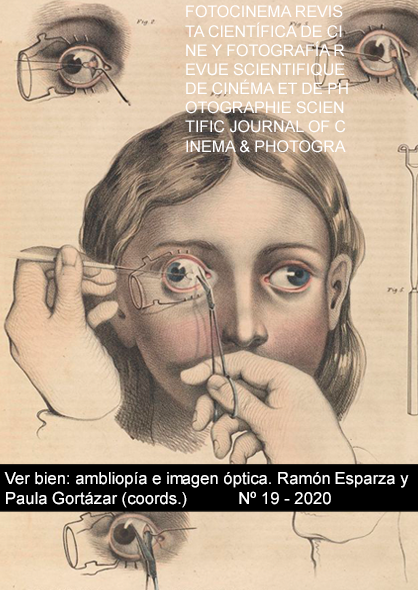All that is solid melts into air. About The killing (Stanley Kubrick, 1956)
DOI:
https://doi.org/10.24310/Fotocinema.2019.v2i19.6654Keywords:
Stanley Kubrick, The Killing, Film analysis, Spatiotemporal representation, Postwar society.Abstract
The present article intends to analyze The Killing (Stanley Kubrick 1956). It establishes a relationship between the narrative configuration of the story and the formation of meanings about the film’s historical and political context. The approach to the film’s formal organization focuses on the study of the modes of representation and construction of time and space, while the historical context is analyzed taking into account the presence of the film noir (crime thriller) in postwar American society. Thus, the analysis of the film’s formal organization is presented as a starting point for the problematization of a certain socio-historical situation. This approach does not imply understanding the cinema as an instance that illustrates a historical moment. Rather, it seeks to analyze it through its links with the social context it is part of and it contributes to shape.
Downloads
Metrics
Publication Facts
Reviewer profiles N/A
Author statements
Indexed in
-
—
- Academic society
- N/A
- Publisher
- Universidad de Málaga
References
Berman, M. (1988). Todo lo sólido se desvanece en el aire. La experiencia de la Modernidad. Madrid: Siglo XXI.
Borde, R. y Chaumeton, E. (1958). Panorama del cine negro. Buenos Aires: Losange.
Bordwell, D. (1996) [1985]. La narración en el cine de ficción. Buenos Aires: Paidós.
Buss, R (2001). French film noir. Londres: Marion Boyars.
Campodónico, H. y Grilli, D. (1993). El cine del malestar. Revista El amante, 2 (12), 21-23.
Chion, M. (1993). La audiovisión. Introducción a un análisis conjunto de la imagen y el sonido. Barcelona: Paidós.
Esquenazi, J.P. (2018). El film noir. Historia y significaciones de un género popular subversivo. Buenos Aires: El cuenco de plata.
Finol, L. (2016). Stanley Kubrick y la espiral del tiempo. Fotocinema: Revista Científica de Cine y Fotografía, (12) 239-262. Disponible: www.revistafotocinema.com/index.php?journal=fotocinema&page=article&op=view&path%5B%5D=357 doi:http://dx.doi.org/10.24310/Fotocinema.2016.v0i12.6045.
Gaudreault, A. y Jost, F. (1995) [1990]. El relato cinematográfico. Barcelona: Paidós.
Genette, G. (1989) [1972]. Figuras III. Barcelona: Lumen.
Heath, S. (1976). Narrative space. Screen, 17 (3), 68-112.
Higham, Ch. y Greenberg, J. (1968). Hollywood in the forties. Londres y New York: Zwemmer and A S Barnes & Co.
Hirsch, F. (2008) [1981]. The dark side of the screen: film noir. UK: Hachette.
Hobsbawm, E. (1998). Historia del siglo XX. Buenos Aires: Crítica.
Jameson, F. (1998). Teoría de la Postmodernidad. Madrid: Trotta.
Kagan, N. (1975). El cine de Stanley Kubrick. Buenos Aires: Ediciones Marymar.
Naremore, J. (2012). El cine negro. En G.P. Brunetta (Dir.), Historia mundial del cine. Madrid: Ediciones Akal.
Marx, K. [1867] (1974). La ideología alemana. Barcelona: Grijalbo.
Metz, Ch. (2002) [1968]. Ensayos sobre la significación en cine, tomo I. Buenos Aires: Paidós.
Ortega y Gasset, J (1916). Verdad y perspectiva. El espectador. Tomo I. Disponible: https://www.ensayistas.org/antologia/XXE/ortega/
Shrader, P. (1972). Apuntes sobre el film noir. Film Comment, 8, (1). Disponible: http://www.historiadeltraje.com.ar/archivos/notas%20sobre%20el%20film%20noir%20paul%20schrader.pdf
Telotte, J.P. (1989). Voices in the dark: the narrative patterns of film noir. Chicago: University of Illinois Press
Tuska, J. (1984). Dark cinema: American film noir in cultural perspective. Westport, Connecticut: Greenwood Press.
Downloads
Published
How to Cite
Issue
Section
License
All contents published in Fotocinema Revista científica de cine y fotografía are protected under the Creative Commons Attribution-NonCommercial-ShareAlike 4.0 International (CC BY-NC-SA 4.0) license. All about this license is available in the following link: <http://creativecommons.org/licenses/by-nc-sa/4.0>
Users can copy, use, redistribute, share and exhibit publicly as long as:
- The original source and authorship of the material are cited (Journal, Publisher and URL of the work).
- It is not used for comercial purposes.
- The existence of the license and its especifications are mentioned.
There are two sets of authors’ rights: moral and property rights. Moral rights are perpetual prerogatives, unrenounceable, not-transferable, unalienable, imprescriptible and inembargable. According to authors’ rights legislation, Fotocinema. Revista científica de cine y fotografía recognizes and respects authors moral rights, as well as the ownership of property rights, which will be transferred to University of Malaga in open access. The property rights are referred to the benefits that are gained by the use or the dissemination of works. Fotocinema. Revista científica de cine y fotografía is published in an open access form and it is exclusively licenced by any means for doing or authorising distribution, dissemination, reproduction, , adaptation, translation or arrangement of works.
Authors are responsable for obtaining the necessary permission to use copyrighted images.














13.png)



